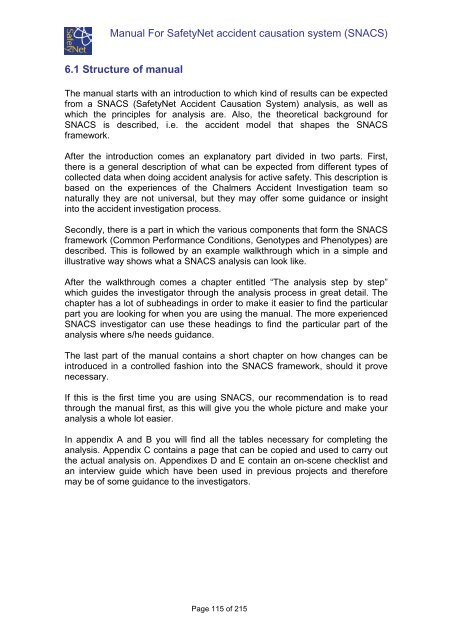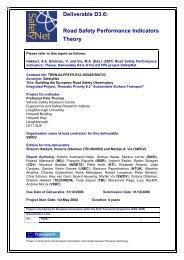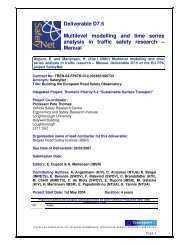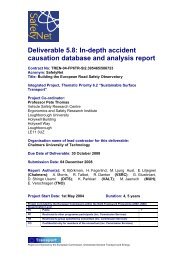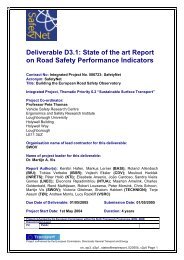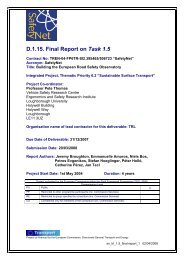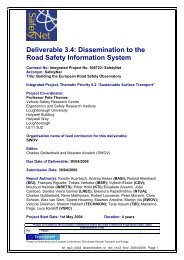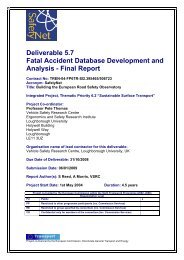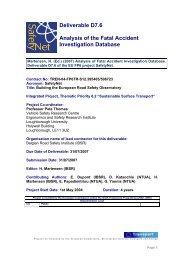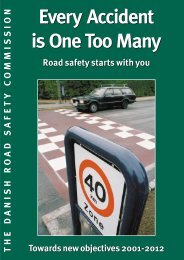Glossary of Data Variables for Fatal and accident causation ... - ERSO
Glossary of Data Variables for Fatal and accident causation ... - ERSO
Glossary of Data Variables for Fatal and accident causation ... - ERSO
Create successful ePaper yourself
Turn your PDF publications into a flip-book with our unique Google optimized e-Paper software.
Manual For SafetyNet <strong>accident</strong> <strong>causation</strong> system (SNACS)<br />
6.1 Structure <strong>of</strong> manual<br />
The manual starts with an introduction to which kind <strong>of</strong> results can be expected<br />
from a SNACS (SafetyNet Accident Causation System) analysis, as well as<br />
which the principles <strong>for</strong> analysis are. Also, the theoretical background <strong>for</strong><br />
SNACS is described, i.e. the <strong>accident</strong> model that shapes the SNACS<br />
framework.<br />
After the introduction comes an explanatory part divided in two parts. First,<br />
there is a general description <strong>of</strong> what can be expected from different types <strong>of</strong><br />
collected data when doing <strong>accident</strong> analysis <strong>for</strong> active safety. This description is<br />
based on the experiences <strong>of</strong> the Chalmers Accident Investigation team so<br />
naturally they are not universal, but they may <strong>of</strong>fer some guidance or insight<br />
into the <strong>accident</strong> investigation process.<br />
Secondly, there is a part in which the various components that <strong>for</strong>m the SNACS<br />
framework (Common Per<strong>for</strong>mance Conditions, Genotypes <strong>and</strong> Phenotypes) are<br />
described. This is followed by an example walkthrough which in a simple <strong>and</strong><br />
illustrative way shows what a SNACS analysis can look like.<br />
After the walkthrough comes a chapter entitled “The analysis step by step”<br />
which guides the investigator through the analysis process in great detail. The<br />
chapter has a lot <strong>of</strong> subheadings in order to make it easier to find the particular<br />
part you are looking <strong>for</strong> when you are using the manual. The more experienced<br />
SNACS investigator can use these headings to find the particular part <strong>of</strong> the<br />
analysis where s/he needs guidance.<br />
The last part <strong>of</strong> the manual contains a short chapter on how changes can be<br />
introduced in a controlled fashion into the SNACS framework, should it prove<br />
necessary.<br />
If this is the first time you are using SNACS, our recommendation is to read<br />
through the manual first, as this will give you the whole picture <strong>and</strong> make your<br />
analysis a whole lot easier.<br />
In appendix A <strong>and</strong> B you will find all the tables necessary <strong>for</strong> completing the<br />
analysis. Appendix C contains a page that can be copied <strong>and</strong> used to carry out<br />
the actual analysis on. Appendixes D <strong>and</strong> E contain an on-scene checklist <strong>and</strong><br />
an interview guide which have been used in previous projects <strong>and</strong> there<strong>for</strong>e<br />
may be <strong>of</strong> some guidance to the investigators.<br />
Page 115 <strong>of</strong> 215


